While in Kyiv, Ukraine, to visit our daughter, we discovered one of the most delightful art museums ever, the Khanenko Museum. The museum is the former home of Bohdan and Varvara Khanenko, who collected gems of both Asian and European art.
|

|
|
Bogdan Khanenko
|
|
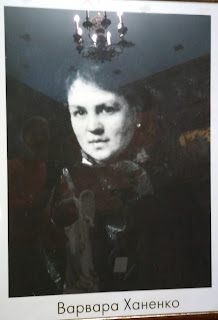
|
|
Varvara Khanenko
|
Two things put this museum a step above many museums.
First of all, the rooms of the Khanenko display the collection by organizing it into historical periods and places, like many museums devoted to art history, but there’s more. Each room is also designed to represent the decorative arts of the period. For example the room devoted to Rococo art is encrusted with gold and mirrors and looks like it might have been moved from some Royalist palace.
|
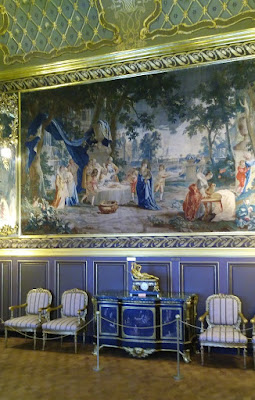
|
|
One wall of the Rococo room
|
|
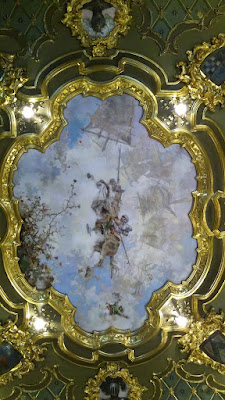
|
|
Part of the ceiling of the Rococo room
|
Secondly, in the corner or every room is a rack with a laminated sheets each one describing and individual piece displayed in the room. The result is that
-
you know who/what the painting/sculpture is about,
-
you know an intriguing story about the painter or the subject, and
-
you learn what distinguishes the painting itself.
Here’s an example of part of one of those sheets - and notice that the sheet is written in very readable ENGLISH - along with the art work it describes.
|

|
|
The sheet describing the relief
|
|

|
|
The relief itself
|
We spent hours reading stories like these - they were just too good to miss!
One of my favorite rooms was the Medieval room - complete with an imported Italian Medieval fireplace from Urbino that has, like everything else in the museum, a laminated sheet to describe it.
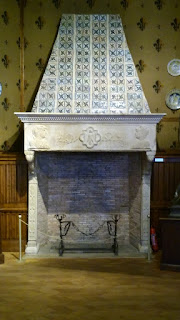
A particularly interesting find in the Medieval room was the statue/story of St. Christopher, rescued 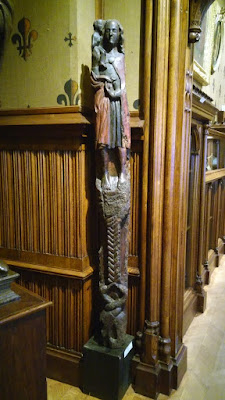 from a Medieval church choir. One quickly learns that St. Christopher existed only in legend.
from a Medieval church choir. One quickly learns that St. Christopher existed only in legend.
According to the legend, there was once a Roman named Reprebus, who made a vow to serve travelers by carrying them across a nearby river.
One day, when he picked up a small child to carry across, he was amazed to find the small child was almost too heavy to carry. When he got to the other side, the Child revealed he was the Christ, and he was carrying all the sins of the world. The Child then baptized Reprebus, naming him Christopher (Christ carrier).
Below the figure you can see rolling swirls representing waves, and at the bottom are two birds - herons or pelicans. Both birds are favorite symbols that early Christians used as symbols of Christ.
We found that treating pictures as stories made them much more interesting, and is the thing that made the Khanenko a model for what art museums could be.
St. Christopher may never have been real, but the legend does make an interesting symbol of what it means to be a Christian.
We also found that the picture-as-story concept resonated with ArtAchieve’s mission of finding art subjects that offer interesting stories.
If you are ever in Kyiv (the city is FULL of delightful treasures), set aside a day for the Khanenko Museum. It'll be time well spent!
Even if you can't travel to Ukraine, you CAN enjoy an art lesson inspired by Ukrainian artists!
Start with one of these lessons today:
While in Kyiv, Ukraine, to visit our daughter, we discovered one of the most delightful art museums ever, the Khanenko Museum. The museum is the former home of Bohdan and Varvara Khanenko, who collected gems of both Asian and European art.
|

|
|
Bogdan Khanenko
|
|

|
|
Varvara Khanenko
|
Two things put this museum a step above many museums.
First of all, the rooms of the Khanenko display the collection by organizing it into historical periods and places, like many museums devoted to art history, but there’s more. Each room is also designed to represent the decorative arts of the period. For example the room devoted to Rococo art is encrusted with gold and mirrors and looks like it might have been moved from some Royalist palace.
|

|
|
One wall of the Rococo room
|
|

|
|
Part of the ceiling of the Rococo room
|
Secondly, in the corner or every room is a rack with a laminated sheets each one describing and individual piece displayed in the room. The result is that
-
you know who/what the painting/sculpture is about,
-
you know an intriguing story about the painter or the subject, and
-
you learn what distinguishes the painting itself.
Here’s an example of part of one of those sheets - and notice that the sheet is written in very readable ENGLISH - along with the art work it describes.
|

|
|
The sheet describing the relief
|
|

|
|
The relief itself
|
We spent hours reading stories like these - they were just too good to miss!
One of my favorite rooms was the Medieval room - complete with an imported Italian Medieval fireplace from Urbino that has, like everything else in the museum, a laminated sheet to describe it.

A particularly interesting find in the Medieval room was the statue/story of St. Christopher, rescued  from a Medieval church choir. One quickly learns that St. Christopher existed only in legend.
from a Medieval church choir. One quickly learns that St. Christopher existed only in legend.
According to the legend, there was once a Roman named Reprebus, who made a vow to serve travelers by carrying them across a nearby river.
One day, when he picked up a small child to carry across, he was amazed to find the small child was almost too heavy to carry. When he got to the other side, the Child revealed he was the Christ, and he was carrying all the sins of the world. The Child then baptized Reprebus, naming him Christopher (Christ carrier).
Below the figure you can see rolling swirls representing waves, and at the bottom are two birds - herons or pelicans. Both birds are favorite symbols that early Christians used as symbols of Christ.
We found that treating pictures as stories made them much more interesting, and is the thing that made the Khanenko a model for what art museums could be.
St. Christopher may never have been real, but the legend does make an interesting symbol of what it means to be a Christian.
We also found that the picture-as-story concept resonated with ArtAchieve’s mission of finding art subjects that offer interesting stories.
If you are ever in Kyiv (the city is FULL of delightful treasures), set aside a day for the Khanenko Museum. It'll be time well spent!
Even if you can't travel to Ukraine, you CAN enjoy an art lesson inspired by Ukrainian artists!
Start with one of these lessons today:
While in Kyiv, Ukraine, to visit our daughter, we discovered one of the most delightful art museums ever, the Khanenko Museum. The museum is the former home of Bohdan and Varvara Khanenko, who collected gems of both Asian and European art.
|

|
|
Bogdan Khanenko
|
|

|
|
Varvara Khanenko
|
Two things put this museum a step above many museums.
First of all, the rooms of the Khanenko display the collection by organizing it into historical periods and places, like many museums devoted to art history, but there’s more. Each room is also designed to represent the decorative arts of the period. For example the room devoted to Rococo art is encrusted with gold and mirrors and looks like it might have been moved from some Royalist palace.
|

|
|
One wall of the Rococo room
|
|

|
|
Part of the ceiling of the Rococo room
|
Secondly, in the corner or every room is a rack with a laminated sheets each one describing and individual piece displayed in the room. The result is that
-
you know who/what the painting/sculpture is about,
-
you know an intriguing story about the painter or the subject, and
-
you learn what distinguishes the painting itself.
Here’s an example of part of one of those sheets - and notice that the sheet is written in very readable ENGLISH - along with the art work it describes.
|

|
|
The sheet describing the relief
|
|

|
|
The relief itself
|
We spent hours reading stories like these - they were just too good to miss!
One of my favorite rooms was the Medieval room - complete with an imported Italian Medieval fireplace from Urbino that has, like everything else in the museum, a laminated sheet to describe it.

A particularly interesting find in the Medieval room was the statue/story of St. Christopher, rescued  from a Medieval church choir. One quickly learns that St. Christopher existed only in legend.
from a Medieval church choir. One quickly learns that St. Christopher existed only in legend.
According to the legend, there was once a Roman named Reprebus, who made a vow to serve travelers by carrying them across a nearby river.
One day, when he picked up a small child to carry across, he was amazed to find the small child was almost too heavy to carry. When he got to the other side, the Child revealed he was the Christ, and he was carrying all the sins of the world. The Child then baptized Reprebus, naming him Christopher (Christ carrier).
Below the figure you can see rolling swirls representing waves, and at the bottom are two birds - herons or pelicans. Both birds are favorite symbols that early Christians used as symbols of Christ.
We found that treating pictures as stories made them much more interesting, and is the thing that made the Khanenko a model for what art museums could be.
St. Christopher may never have been real, but the legend does make an interesting symbol of what it means to be a Christian.
We also found that the picture-as-story concept resonated with ArtAchieve’s mission of finding art subjects that offer interesting stories.
If you are ever in Kyiv (the city is FULL of delightful treasures), set aside a day for the Khanenko Museum. It'll be time well spent!
Even if you can't travel to Ukraine, you CAN enjoy an art lesson inspired by Ukrainian artists!
Start with one of these lessons today:
 from a Medieval church choir. One quickly learns that St. Christopher existed only in legend.
from a Medieval church choir. One quickly learns that St. Christopher existed only in legend.







